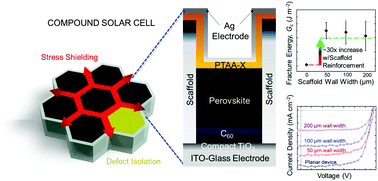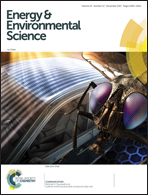Scaffold-reinforced perovskite compound solar cells†
Abstract
The relative insensitivity of the optoelectronic properties of organometal trihalide perovskites to crystallographic defects and impurities has enabled fabrication of highly-efficient perovskite solar cells by scalable solution-state deposition techniques well suited to low-cost manufacturing. Fracture analyses of state-of-the-art devices, however, have revealed that both the perovskite active layer and adjacent carrier selective contacts are mechanically fragile—a major obstacle to technological maturity that stands to significantly compromise their thermomechanical reliability and operational lifetimes. We report a new concept in solar cell design, the compound solar cell (CSC), which addresses the intrinsic fragility of these materials with mechanically reinforcing internal scaffolds. The internal scaffold effectively partitions a conventional monolithic planar solar cell into an array of dimensionally scalable and mechanically shielded individual perovskite cells that are laterally encapsulated by the surrounding scaffold and connected in parallel via the front and back electrodes. The CSCs exhibited a significantly increased fracture energy of ∼13 J m−2—a 30-fold increase over previously reported planar perovskite (∼0.4 J m−2)—while maintaining efficiencies comparable to planar devices. Notably, the efficiency of the microcells formed within the scaffold is comparable to planar devices on an area-adjusted basis. This development is a significant step in demonstrating robust perovskite solar cells to achieve increased reliability and service lifetimes comparable to c-Si, CIGS, and CdTe solar cells.



 Please wait while we load your content...
Please wait while we load your content...